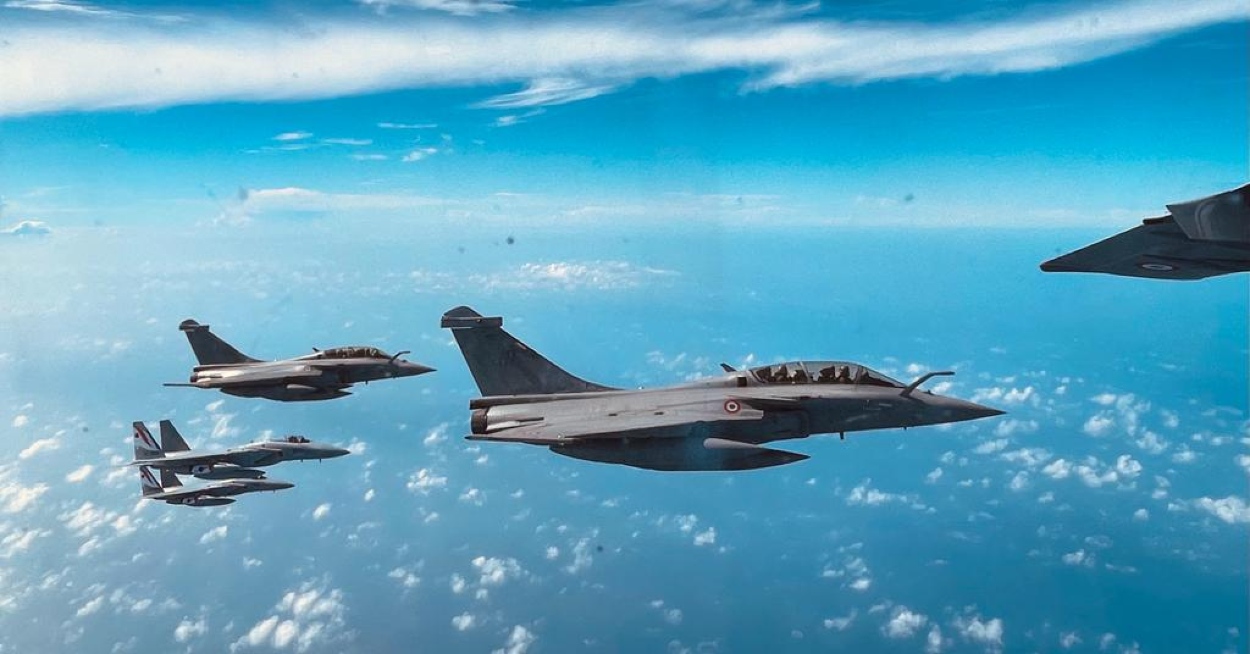Years after its Sukhoi Su-30 MKI “over-powered” USAF F-15s, the Indian Air Force (IAF) Rafale fighters gave a tough fight to American-made warplanes during the recently concluded Red Flag exercises.
In the 2008 edition of Red Flag, the IAF sent its Su-30MKI and went up against F-15s and F-16s. Following the wargames, U.S. Air Force pilots anonymously put an assessment on YouTube. They said that the American fighters would soon lose their competitive edge to the Russian fighters. It was the first time the Su-30MKI featured in an international wargame of this scale and crossed swords with advanced Western fighters.
The F-15 pilots have gained amazing experience against the thrust vectoring capability of Lockheed Martin’s F-22 which helped them exploit the vulnerability of the Su-30 in a hard turn.
A USAF pilot shared his assessment of the two fighter jets going against each other. “So we start to pull in on him, and then all of a sudden you start to see the [Su-30’s aft-] end kick down, and he starts doing vectored thrust,” the pilot was quoted saying.
“But now he starts falling out of the sky. He’s falling out of the sky so fast that you don’t even have to go up,” the pilot adds. “You just have to pull back on the stick a little bit, pull the throttle, go to guns, and come in and drill his brains out.” Even so, the professionalism and skill of the IAF pilots at Red Flag gained the respect of the USAF pilots.
Sixteen years later, the French-made Rafales in the IAF fleet matched the F-15s’ capability in the Red Flag exercise at Eielson Air Force Base, Alaska. The two fighter jets did not engage in any dogfights.
Red Flag is an air combat exercise with multiple scenarios designed to provide realistic combat settings. The participating forces are divided into the Red Force, which simulates Air Defence elements, and the Blue Force, which simulates Offensive Composite elements. During this exercise, the Red Force was mainly constituted by the USAF Aggressor Squadron, which flew the F-16 and F-15 aircraft.
This was the first time the IAF Rafale aircraft participated in Ex Red Flag, wherein they operated alongside the RSAF (Singapore), USAF F-16 and F-15s, and USAF A-10 aircraft. The missions included Beyond Visual Range (BVR) combat exercises as part of large force engagements (LFE) in Offensive Counter-Air and Air Defence roles.
An IAF source told the EurAsian Times: “The interaction was limited only to BVR, so limited interaction. But performance at higher levels was equivalent to ours.” The F-15 fighter jet belonged to Republic Singapore Air Force, but the weapons belonged to the USAF.
Rafale’s BVR rating is 90 percent, and it is armed with an Air-to-air missile (AAM) MBDA Meteor with a range of 100 kilometers. In comparison, F-15EX has a BVR rating of 88 percent. It has an AAM AIM-120 AMRAAM with a range of 75 kilometers.
For dogfights, it has a 30 mm GIAT 30M/719B cannon, and the F-15EX has a 20 mm M61A1 Vulcan gun and AIM-7 Sparrow medium-range semi-active radar homing air-to-air missile.
IAF Rafales might not have got a chance to go up against F-15s, but the pilot assessing the 2008 performance of Su-30MKIs had high praises for MiG-21 Bison aircraft, modified with Israeli radar, active radar missiles, and electronic jammers as they were nearly “invisible” to F-15 and F-16’s then mechanically-scanned arrays. It allowed the Indian pilots to sneak past the USAF radar screen and engage the two American fighter jets in dogfights.
“The MiG-21 had the ability to get in the scissors with you at 110kts at 60 degrees nose high and go from 10,000 to 20,000 feet,” he said.

When USAF’s F-15C Jets Were Creamed IAF
This tale has been legendary in the history of the U.S. and Indian wargames. Cope India 04 was held at the Gwalior airbase of the IAF from February 15 to 27, 2004. During the exercise, the Indian pilots ‘trounced’ U.S. Air Force F-15C jets 90 percent of the time.
The Pentagon later defended the outcome, stating that the Rules of Engagement were skewed in favor of the Indian fighter jets. The F-15s did not have the Advanced Active Electronically Scanned Array (AESA) radars. (The new F-15 EX has AESA Radars.)
Secondly, the air engagements typically involved six Eagles against up to eighteen IAF aircraft, with no chance to simulate any beyond-visual-range (BVR) combat (due to the Indian request not to use the AMRAAM).
The other problem was that the IAF sent their most experienced pilots against the Americans, who had a mix of experienced and inexperienced pilots.
David A. Fulghum, in its Cope India report, quoted Colonel Mike Snodgrass, commander of the 3rd Wing, as saying: “The outcome of the exercise boils down to (the fact that) they ran tactics that were more advanced than we expected…They could come up with a game plan, but if it wasn’t working, they would call an audible and change (tactics in flight).”
The F-15Cs faced Su-30MKs, the less advanced fighter jets that also lacked the AESA radar. The other aircraft the F-15C faced was the MiG-21 Bison, an upgraded version of the Russian-made MiG-21.
Low radar visibility, instantaneous turn rate, acceleration, and helmet-mounted sight combined with high-off-boresight R-73 air-to-air missiles were among the factors that made the upgraded MiG-21 a formidable adversary for the US F-15s.
- Ritu Sharma has been a journalist for over a decade, writing on defense, foreign affairs, and nuclear technology.
- The author can be reached at ritu.sharma (at) mail.com
- Follow EurAsian Times on Google News